Leafy Spurge: Biology, Ecology and Management
Last Updated: 01/03by Kim Goodwin, Project Specialist, MSU-Bozeman; Roger Sheley, associate professor and MSU Extension noxious weeds specialist, MSU-Bozeman; Robert Nowierski, former MSU-Bozeman entomologist; and Rodney Lym, professor, North Dakota State University
BIOLOGY AND MANAGEMENT
Leafy spurge (Euphorbia esula L.) is a deep-rooted, long-lived perennial native to Eurasia. It may have been introduced to North America in the 19th Century as an ornamental or contaminant in imported grain or ballast water. Spurge is widespread throughout the United States and southern Canada. Since its intro- duction, spurge has become a serious management problem, particularly for the north and central plains states.
Habitat
Leafy spurge grows in a variety of dry and moist habitats ranging from flood plains and riverbanks to grasslands, ridges and mountain slopes. It frequently infests rough terrain, hindering access for management by conventional means. Leafy spurge can dominate bottomlands and is commonly found in abandoned cropland, pastures, rangeland, road-sides and waste areas. It is found less frequently on top slope, summit and shoulder slopes. This weed is aggressive, especially in disturbed or dry situations where plant competition is less intense.

Figure 1. Leafy spurge is distinguished from plants that are similar in appearance by a white milky latex which is present throughout the plant. Photo courtesy www.invasive.org
Impacts
The direct impact of leafy spurge is the reduction or entire local displacement of native plant com- munities. This dramatically alters ecosystems by affecting the prop- erties of soils and the composition and function of plant and animal communities. These ecologic changes directly affect local and regional economies through reduced recreational and agricultural revenue. The cost of management is very high.
Due to its extensive root system, herbicide management of established stands is costly and requires repeated periodic application. For large infestations, herbicidal management costs may exceed the value of the land.
Leafy spurge is a serious problem in cropland, where herbicide rates required for effective control are higher than labels permit. As of 1999, over 2.7 million acres were infested, mainly in the Northern Great Plains and the prairie provinces of Canada. Economic losses in North Dakota alone exceed $14.4 million per year due to reduced cattle forage production and control costs. In many states, including Montana, North Dakota and Wyoming, leafy spurge is designated a “noxious weed,” meaning landowners or managers are legally responsible for its control.
Identification
Leafy spurge stems are hairless, pale- to blue-green and can reach 32 inches tall. Spurge leaves are linear to slightly oblong and alternate on the stem. When the plant is injured, a milky latex sap flows from the injury (Figure 1). The small flowers are green and inconspicuous, surrounded by a pair of yellow-green heart- shaped leaves (bracts) that are often mistaken for flowers (Figure 2).

Figure 2. The inconspicuous true flowers of leafy spurge are surrounded by showy yellow- green bracts.
BIOLOGY
Life Cycle
Leafy spurge begins growing in early spring when temperatures still fluctuate around freezing. It grows from buds on roots and at the junction between root and stem (the crown) (Figure 3), as well as from seeds. Seedlings may be deep red or purplish in color at this time. New growth from rootstock usually begins in late April in northern climates, providing a competitive advantage as one of the first plants to emerge and initiate growth. Peak period of seed germination occurs from late May to early June in northern climates, but some germination can occur any time adequate soil moisture is available.

Figure 3. Leafy spurge roots have numerous vegetative buds which contribute to the spread and persistence of the weed. Photo courtesy www.invasive.org
Yellow-green bracts develop on stems in May or early June in the northern climates, giving the plant the appearance of “blooming.” The small, green flowers develop about two weeks later. Flowering is usually completed by mid-July with seeds developing 20 to 30 days later. (Calendar dates will vary with climate and geographic location.) Leafy spurge becomes dormantn in some areas during late summer, but growth can resume in the fall. Summer dormancy does not occur in some regions, or in wet, cool years.
Seeds
Each flower produces a lobed capsule containing three seeds (Figure 4). When the stem matures, the capsules explode, projecting seeds up to 15 feet. Each flowering stem may produce and disperse over 200 seeds with a germination rate of 60-80 percent; temperatures from 68° to 86° Fahrenheit are optimum for seed germination. However, the key reproductive capabilities of spurge are rhizomes that provide rapid vegetative spread.

Figure 4. Leafy spurge plants have lobed capsules which contain one to three seeds. The capsules explode when dry, projecting seeds up to 15 feet from the plant.
Leafy spurge seeds are spread several ways. Individuals can spread seed through clothing attachment or muddy boots and seeds or root fragments attached to vehicles and equipment. Seeds can be spread by animals when they attach to their coat, are ingested or transported in the mud on their feet. The seeds float on water, often resulting in new infestations along ditches, rivers and in areas that are periodically flooded. Seeds and sometimes pieces of roots are widely spread as contaminants in crop seed and feed grain or hay.
Seed production can occur throughout the summer if adequate soil moisture is available
Seedlings
Seedlings develop stem and root buds about 12 days after emergence with new shoots developing rapidly if the main shoot is injured or removed. Spurge seedlings are poor competitors with mortality around 80 percent, but survivors grow rapidly, becoming highly competitive within four months. After this, the seedlings can outcompete most range plants. In the absence of plant competition, seedling roots can grow downward three feet and spread laterally 40 inches in four months. By the second year, spurge can be well established (Figure 5). Seedlings rarely flower the first year.

Figure 5. Root system of a two-year-old leafy spurge plant.
Shoots
Spurge shoots develop from numerous stem and root buds as well as from seeds. Stem buds cause branching of stems, while new shoots develop from root buds to become independent plants. Vegetative root buds will produce new shoots randomly and when older shoots are removed or the crown is damaged. These new shoots are aggressive and highly competitive given the immediately available reserves provided by the extensive root system.
Roots
The root system is comprised of both vertical and horizontal roots (rhizomes). Main vertical roots can grow to depths of 26 feet and rhizomes can extend 15 feet per year from the parent plant. The extensive root system contains vast reserves capable of sustaining an infestation for many unfavorable years, enabling leafy spurge to survive drought or after control measures are taken.
Root buds are maintained in various stages of dormancy until growing conditions are suitable, which is one reason leafy spurge persists despite various attempts at control. Researchers are investigating genetic pathways that regulate bud dormancy, development and growth. Genes that are proven to have essential roles in controlling root buds may be used to develop “bio-herbicides” as a new management tool.
Management
Many reintroductions and crosses of leafy spurge have occurred since the 19th Century, resulting in a highly diverse and complex population throughout North America (Figure 6). The genetic diversity of leafy spurge in North America has led many experts to believe it is a hybrid between two or more Old World spurges. This extreme plasticity results in quick adaptation to local growing conditions and often-inconsistent responses to management.
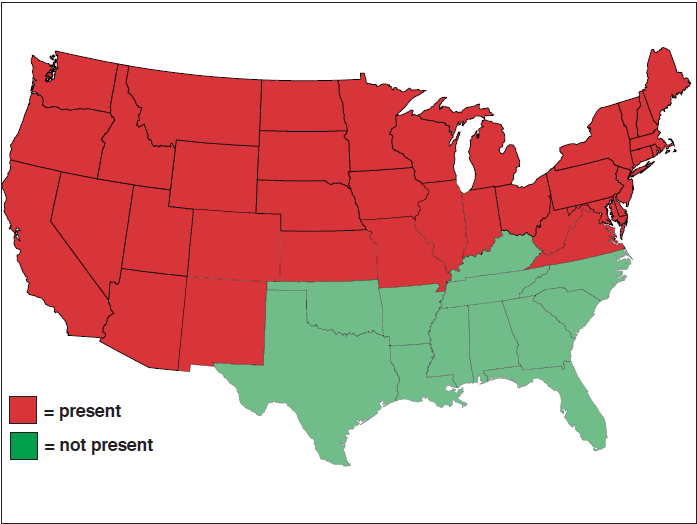
Figure 6. Distribution of leafy spurge in the United States in 1999. U.S. counties reported presence or absence, not actual infested areas. Source: USDA, NRCS 1999. The PLANTS database (http://plants.usda.gov/plants). National Plant Data Center, Baton Rouge, LA 70874-4490 USA.
Prevention
Preventing leafy spurge invasion and establishment is the most effective and least costly management. To prevent its invasion:
- Avoid importation of machinery, feed or livestock that might carry leafy spurge root fragments or seeds;
- Purchase only certified weed-free forage, seed and gravel;
- Minimize soil disturbance by vehicles, machinery and livestock;
- Implement effective management on adjacent leafy spurge populations to prevent vegetative spread and limit seed dispersal;
- Properly manage desired plant communities to encourage continued growth and vigor to suppress leafy spurge invasion, establishment and growth.
Early Detection and Rapid Response
Spurge-free areas should be actively protected from invasion, establishment and growth. This can be accomplished through frequent and systematic on-the-ground surveys to locate new leafy spurge plants early, when removal is still inexpensive and easy. Conducting systematic sampling methods throughout the management area and especially along pathways, such as roadsides and water- ways, ensure thorough and frequent surveys.
Small Patches
When leafy spurge is newly established and confined to small, well-defined areas, eradication should be implemented with highest priority while still possible. Small patches that expand into large infestations will persist and eradication will be unattainable. Herbicide treatments should begin immediately to prevent vegetative spread and seed production. Visit the patch frequently to spot-spray newly emerging seedlings and to monitor treatment effectiveness. Annually evaluate management towards eradication to allow for timely adjustments, if needed. An integration of herbicide treatments and cultural control methods can be implemented to eradicate small spurge patches. Herbicide treatments could provide spurge removal while revegetation with competitive grasses and management encouraging desired vegetation growth could provide resource competition. Neither biological control nor grazing can eradicate small patches, because these methods work slowly and will not prevent seed production (in the caseof biocontrol). If seeds have been produced, the site should be monitored for a minimum of eight years, the average period of time spurge seeds remain viable in the soil.
Large infestations
Successful management of leafy spurge infestations requires the use of all available control methods that can effectively weaken the extensive root system and work towards the reestablishment of a healthy, productive plant community. Management of large infestations must be considered a long-term suppression program since eradication of the mature root system typically is not possible. Frequent management with regular visits to monitor treatment effectiveness will be necessary. Annually evaluate management efficacy to allow for timely adjustments, if needed. Four methods, when integrated, are used to manage leafy spurge: physical; cultural; biological; and chemical control.
PHYSICAL CONTROL
Physical control of leafy spurge is primarily by cultivation. Mowing and burning are also used, but are less successful and should be combined with herbicide treatments. Hand-pulling is usually ineffective unless the plants are in their first year of growth.
Cultivation
Cultivation is used on cropland, where few other options for control are available. Tillage alone as a control method should be timely and intense, as leafy spurge can recover quite rapidly from cultivation with root fragments producing new shoots. It is recommended that spurge-infested areas be cultivated every three weeks throughout the growing season. Tillage can be reduced when used in combination with a recommended herbicide in the fall. The herbicide should be applied a minimum of one week prior to the tillage operation to allow for translocation of the herbicide to the roots. There are generally two types of tillage programs for leafy spurge control: intensive throughout the growing season and fall-only cultivation. Intensive tillage programs should begin in the spring, two to four weeks after leafy spurge emerges. Use a duck-foot cultivator and till four inches deep, repeating every three weeks until the soil freezes in the fall, for one to two growing seasons. The cultivation schedule should not be interrupted because leafy spurge resprouts quickly. Pieces of roots as small as one-half-inch long and one-tenth-inch diameter may produce new shoots.
Care should be taken to avoid transporting root pieces on machinery into uninfested portions of the field or other areas
Fall-only cultivation should be done once or twice when leafy spurge regrowthis three to six inches tall for three years. Fall-only cultivation allows crops to be grown during the season, limits organic matter degradation and reduces soil erosion when compared to season-long cultivation. Cultivation integrated with herbicides enhances leafy spurge control. Herbicides such as Roundup® should be applied at label rates at least seven days before the first fall cultivation.
Mowing and Burning
Mowing and burning are ineffective for reducing leafy spurge infestations because the extensive and deep root system simply resprouts. But mowing or burning prior to herbicide treatments may provide uniform regrowth for more effective herbicide treatment and allow reduced rates of applied herbicides to provide effective shoot control. For best results, allow at least five weeks of regrowth before herbicide application. Mowing will reduce seed production if repeated every two to four weeks during the growing season, but will provide little long-term control. Mowing and herbicides combined with applications of nitrogen fertilizer to stimulate grass growth does not control leafy spurge better than herbicides applied alone. Burning can stimulate vegetative growth from root buds, causing the infestation to be more vulnerable to herbicide treatment. Burning can also increase visibility of leafy spurge plants and can improve herbicide spray coverage by eliminating old stems and ground litter. Burning integrated with herbicide applications may also reduce spurge seed viability.
Prescribed burning can be hazardous and should be conducted only by trained professionals
Pulling by Hand
Pulling leafy spurge by hand is usually ineffective, even for small isolated patches, because the entire root system must be excavated for complete control. The depth of the root system (Figure 7) and the large number of root buds that are stimulated to produce new, individual plants following removal of top growth make hand pulling or digging impractical. Also, pulling and digging can break the root into smaller pieces, leaving portions to resprout. However, it may be possible to hand pull a few plants that are in their first year of growth, if follow-up visits are implemented to ensure new shoots were not produced. Early detection and hand pulling during first-year growth is especially important where control options are limited, such as in riparian areas.
CULTURAL CONTROL
Cultural control methods promote the growth and competitiveness of desired plants by establishing and properly managing diverse, healthy plant communi- ties. This can provide resource competition with spurge and relative weed-resis- tance to future invaders. Leafy spurge seedlings are poor competitors in healthy rangeland communities, but in the absence of plant competition, rapid seedling growth is ensured. Cultural control methods include revegetation when desired plant cover is inadequate and carefully timed grazing to ensure proper manage- ment of desired plants.

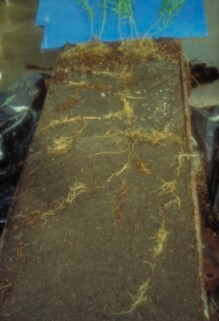
Figure 7. The ten-feet-deep excavation at left shows only a part of a well-established leafy spurge plant’s root system. It is the network of roots close to the surface as shown in Figure 5 that compete with other plants, but these deep roots allow the plant to survive years of drought or after control measures.
Revegetation
Spurge-infested rangeland with inadequate desired plant canopy cover, typically less than 20 percent, can benefit from competitive grass reseeding. Reseeding with a functional diversity of aggressive grasses and shrubs may provide a more competitive environment than reseeding with any single species. Plant early-germinating species to compete with leafy spurge seedlings for early season moisture and include species that grow late in the season to compete with fall regrowth of leafy spurge. When one species matures or enters its dormant phase, another should be starting its active growing phase to continue competition for moisture and nutrients. Where the roots of one species end in the soil profile, the roots of another, deeper-rooted species can compete for deep soil moisture and nutrients.
Do not include forbs in a seed mix if broadcast treatments of broadleaf herbicides are anticipated
| Table 1. Grasses competitive with leafy spurge | ||||
| Grass | Growth form | Soil type | Minimum precipitation | Relative establishment |
| Non-native grasses | ||||
| ‘Bozoisky’ Russian wildrye (Psathyrostachys juncea) | Tall bunchgrass | Silty-loamy to clayey | 12 inches |
Difficult |
| ‘Luna’ pubescent wheatgrass (Elytrigia intermedia ssp. trichophorum) | Tall rhizomatous |
Sandy to clayey |
12 inches |
Easy |
| ‘Rebound’ smooth brome (Bromus inermis) | Tall rhizomatous | Sandy to clayey | 15 inches | Easy |
| ‘Arthur’ Dahurian wildrye (Elymus dahuricus) | Medium-tall bunchgrass | Sandy to clayey | 12 inches |
Easy |
| Native grasses | ||||
| ‘Critana’ thick spike wheatgrass (Elymus lanceolatus) | Medium rhizomatous | Sandy to silty-loamy | 14 inches |
Fairly easy |
| ‘Trailblazer’ switchgrass (Panicum virgatum) | Tall rhizomatous | Silty-loamy to clayey | 18 inches | Moderate |
| ‘Rosana’ western wheatgrass (Pascopyrum smithii) | Medium-tall rhizomatous | Silty-loamy to clayey | 10 inches |
Fairly easy |
Several competitive grasses (Table 1) have been evaluated for establishment and production in leafy spurge-infested areas and can influence significant top growth reduction in spurge. Successful reseeding includes properly timed herbicide applications to reduce interference of spurge while seeded species are establishing. A recent study conducted on spurge-infested sites in Nebraska showed fall treatments of imazapyr with sulfometuron greatly increased yields of planted tall grasses compared to reseeded areas where no herbicide was used. Others have found success with glyphosate applied alone or with 2,4-D applied once during June and repeated in July will control leafy spurge prior to grass seeding, allowing the grasses to establish in mid-August. The effectiveness of seeded species competition with leafy spurge varies by region. Consult your local county Extension agent, weed coordinator or Natural Resource Conservation Service Field Office for grass or shrub species selection, seeding methods and proper timing suggestions.
Grazing
Leafy spurge is particularly invasive in areas with low competitive plant cover, especially if these plants are managed poorly. Grazing programs that allow consistent and heavy selection of desired grasses and avoidance of leafy spurge enhance the success of the weed. Multi-species grazing programs that incorporate sheep or goat grazing are encouraged to equalize grazing pressure on all plants across pastures.
Grazing Management
Rangelands should be managed under a grazing program that encourages the growth and vigor of the competitive plant community. This includes avoiding improper grazing practices that can favor leafy spurge. Improper grazing by cattle may encourage and increase leafy spurge infestations. A grazing management program should include the following methods that encourage competitive plant growth, directly enhancing and promoting a healthy rangeland system:
- Avoid heavy grazing by implementing proper stocking rates;
- Avoid grazing actively growing grasses;
- Alter the season of use – avoid grazing the same plants at the same time year after year;
- Rotate livestock between pastures to allow plant recovery before being re- grazed; and
- Minimize bare ground by promoting plant litter accumulation.
To encourage competitive plant growth and vigor, cattle could graze leafy spurge-infested pastures either before grasses begin their active growing phase or after grasses have dispersed seeds. In multi-species grazing programs, cattle may harvest the grass before sheep are placed in areas with light infestations. This will enable sheep to remove leafy spurge more efficiently. Cattle can also be allowed to harvest grass late in summer before sheep are placed in the area to graze spurge regrowth.
Multi-species grazing could be integrated with a cattle operation to distribute grazing pressure more uniformly across pastures and among plants, including leafy spurge. On moderately stocked rangelands, one ewe can be added per cow/calf pair without reducing cattle production. When performed properly, integrating sheep with cattle grazing can direct a rangeland system towards a highly productive, perennial grass climax community.
Grazing as a management tool
Dietary preferences
Cattle tend to prefer grasses to forbs and shrubs for forage. As a result, shrubs and native and nonnative broad-leaved plants (i.e., leafy spurge) increase in a plant community exclusively grazed by cattle. In contrast, grasses tend to increase in plant communities grazed by sheep, which have a dietary preference for forbs, or goats, which have a dietary preference for woody plants (Figure 8).
Cattle avoid heavy spurge infested areas and rarely, if at all, graze leafy spurge. The milky latex is a digestive tract irritant to cattle and contact can result in lesions around the eyes and mouth. But leafy spurge provides good forage for sheep and goats. When sheep or goat grazing is performed properly, leafy spurge can be controlled while grass production is enhanced.
When spurge is grazed, the regrowth is often succulent and sheep will continue to select it into early fall
Although grazing itself does not kill leafy spurge, it can prevent seed produc- tion and if grazed at a sufficient and proper intensity, will lead to a depletion of root reserves and an associated decrease in spurge vigor. This will result in a reduced ability of the weed to compete with neighboring grasses and withstand effects of herbicides or other control methods.

Figure 8. Average dietary overlap between cattle, sheep and goats.
Nutrient content
The nutrient content and digestibility of spurge meets the nutritional needs of the different classes of both sheep and goats. Crude protein ranges from 27 percent in the early vegetative stage to 19 percent during flowering. Digestibility is about 80 percent early in the season dropping to 60 percent late in the season. Phosphorus content is remarkably high throughout the season.
Timing of grazing
When using sheep grazing as a management tool, place sheep in the infested area early while the spurge is still young and succulent – usually this period is when the spurge is between 2 to 6 inches tall. In heavily infested areas, sheep should be corralled to allow them to acquire a taste for the plant; there may be a two to three week adjustment period before they begin to aggressively consume spurge. Sometimes active preference for leafy spurge is enhanced on soils with relatively high fertility.
Shifting the competitive advantage from leafy spurge
As sheep or goat grazing defoliates and weakens an infestation, the resources used by the spurge are made available to the neighboring grasses. This increases grass vigor and, over time, the competitive advantage is shifted from leafy spurge to the grasses. A long-term grazing commitment is necessary, since leafy spurge can quickly recover after the grazing pressure is removed. Depending on species, environment and other factors (Figure 9), it takes at least three years, and often longer, for communities to shift from leafy spurge to grass.
When using sheep or goats to manage leafy spurge, it is essential to regularly monitor utilization. To advance the shift from spurge to grass, enhance the vigor of neighboring grasses by removing the grazing animals when they begin utilizing the grasses. This usually occurs after the animals have grazed spurge until “the yellow is gone” (referring to the yellow bracts).
To encourage grass vigor and produce seeds for the following year’s stand, cattle should graze grasses when they are mature or have dispersed seed. Conversely, grazing leafy spurge with sheep or goats should be implemented sooner, to minimize flower and seed production. The infestation must be grazed often enough and at sufficient stocking rates to deplete root reserves over time, effectively reducing the competitiveness of the leafy spurge.
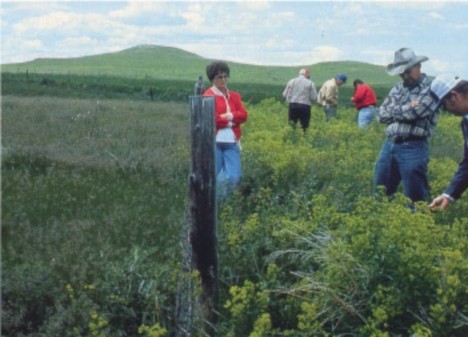
Figure 9. Landowners observe the effects of cattle grazing (right) and sheep grazing (left) on land infested with leafy spurge.
Sheep vs. goats
The relative ability of sheep and goats to control leafy spurge varies with the type of plant community. For example, sheep might be used in areas where preserving woody vegetation is important since goats will browse woody species in addition to forbs and grasses. Goats are best used in areas where terrain is too rough for sheep or where burrs or other plants that are problematic for sheep are plentiful. Although goats are sometimes better suited to a particular area, they require more management than sheep and markets may be more limited.
Stocking rates for sheep and goats vary with terrain, leafy spurge density and rainfall. About three to six sheep per acre of leafy spurge per month (or one to two ewes with lambs per acre per summer) is suggested. Twelve to 16 Angora goats per acre of leafy spurge per month or three to four goats per acre of leafy spurge for four months may be sufficient. Stocking rates may have to be adjusted to prevent flowering. Reduce stocking rates as the season progresses to minimize grass defoliation.
Grazing spurge with sheep
When properly performed, sheep or goat grazing can reduce or prevent seed production while sufficiently suppressing a spurge infestation to encourage grass reestablishment, so that cattle may be reintroduced. With lighter infestations, sheep or goats can be permitted to graze, perhaps in rotation, along with cattle in a multi-species grazing program.
If sheep are leased, a contract of at least five years might be necessary for the project to be feasible for the sheep producer. An intensive grazing system that includes a minimum of two grazing periods in a season, each followed by a rest period to allow grass regrowth, is more effective than season-long grazing.
Keep the following guidelines in mind when managing spurge with sheep:
- Grazing should begin in early spring when leafy spurge plants are two to six inches tall.
- Graze until “the yellow is gone,” then move the sheep when 15 percent grass utilization has been reached. (During early season grazing, yellow bracts do not develop).
- Breeding schedules should be timed so lambing is completed by May. Herders or portable electric fencing may be necessary in many operations.
- Check with predator management professionals before deciding to use sheep—consider hiring a herder or using livestock guardian dogs to protect sheep against predators. Wethers may also be used—they range farther and sometimes experience fewer problems with predators.
- A long-term grazing commitment is necessary. During the first few years, sheep grazing can initially stimulate leafy spurge shoot production from root buds and increase stem densities. But over time (at least three years), continuous infestation grazing can begin affecting underground reserves and eventually reduce stem densities. Use rotational grazing strategies by removing the sheep when “the yellow is gone” and returning the sheep when the spurge again reaches two to six inches in height.
- Grazing periods should be timed to minimize defoliation of grasses during active growth. In spurge-infested areas, consider grazing sheep when the grasses have reached dormancy.
- The goal of grazing leafy spurge with sheep is to prevent seed production. If grazing occurs during seed production, corral the sheep for at least a week to pass seeds from their digestive tracts before they are moved to an uninfested area. Movement of sheep from leafy spurge-infested areas to uninfested areas should be minimized to prevent transport of seeds.
- Sheep grazing integrated with other methods can heighten management effectiveness.
Grazing integrated with other methods
A herbicide application of picloram at one quart + 2,4-D at one quart per acre in mid-September following fall grazing has provided good spurge control in many areas. Allow three to four inches regrowth before applying herbicides. Grazing can also be combined with herbicides around the fringes of infestations to prevent spread.
Sheep have been used with positive results in conjunction with insect bio-controls, such as flea beetles (Aphthona spp.). Sheep grazing occurs once in spring and again in fall. This schedule avoids disturbing adult beetles when they are laying eggs and feeding. Sheep grazing with competitive grass revegetation can be another integrated approach to manage leafy spurge.
BIOLOGICAL CONTROL
In countries of its origin, leafy spurge is a member of the native plant community, controlled by insects, plant diseases, plant competition, grazing and other environmental factors. These controls were left behind when spurge was introduced to North America, resulting in its unchecked spread. Insects that attack the weed in its native lands have been collected, tested for feeding preferences and released on leafy spurge in North America. Only biological control agents that did not feed on crop and ornamental plants in the feeding preference trials have been approved for release in the U.S. and Canada. Plant pathogens that attack leafy spurge are also being tested. These biological control agents—or biocontrols—will not eradicate spurge, but may reduce populations over time (Figure 10).
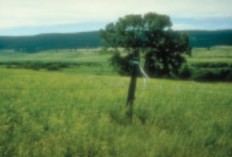
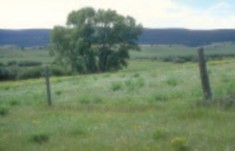
Figure 10. Left: Leafy spurge infested site (N-Bar Ranch, Grass Range, Montana). Right: Same site, four years after release of Aphthona nigriscutis beetles.
Insect Biocontrol Agents
A number of insect biological control agents of leafy spurge have been approved for introduction into the United States. At present, the most effective and well-established biocontrol agents in Montana include two flea beetle species, Aphthona lacertosa and A. nigriscutis and the stem/root-boring beetle, Oberea erythrocephala.
Aphthona lacertosa
This Aphthona species is native to Eurasia where it is associated with loamy/ loamy-clay soils, in either dry or wet habitats. Aphthona lacertosa (Figure 11) establishment and its impact on leafy spurge have been greatest at moderately dry to moist sites in the United States. Unlike A. nigriscutis, which appears to be restricted to drier sites, A. lacertosa has broader ecological amplitude and may have greater potential for controlling leafy spurge across a broad range of habitats.

Figure 11. Aphthona lacertosa. Photo by Noah Poritz.
Aphthona nigriscutis
This flea beetle is native to Europe and is adapted to drier sites and sandier soils. Aphthona nigriscutis (Figure 12) has been most successful in establishing and controlling leafy spurge in dry, open, sandy-loam sites in Canada and the United States. It generally has performed poorly when released in high-density leafy spurge infestations occurring in heavier clay soils. Populations of this flea beetle, which have established in North America, have a female-biased sex ratio. This means that a typical field population will be 85-99 percent female. Thus, it is important that collections of this flea beetle be delayed until July, to give the females a chance to successfully mate with the relatively low number of males. If collections are made too early, such as in June, most of the females will be unmated and as a consequence the release population may fail to establish.

Figure 12. Aphthona nigriscutis. Photo by Noah Poritz.
Oberea erythrocephala
The longhorn beetle, Oberea erythrocephala (Figure 13), is native to Eurasia where it feeds within the stems and roots of spurge. Adults appear in early to mid-summer when spurge is in flower and feed on the young leaves, flowers and stem tissue for approximately two weeks before beginning egg laying. Adult beetles girdle the upper part of the stem, chew a hole in it just above the girdle, insert an egg and cover it with latex. Larvae take approximately one month to mine their way down the stem into the crown and roots. Larvae feed within crowns or roots until March or April and pupate within cells in the root crown in May. This biocontrol has been most effective in attacking leafy spurge growing in sunny sites near streams, or along the banks of major rivers, such as the Yellowstone River near Columbus, Montana. Unfortunately, its record of establishment and impact has been less consistent than that realized by the two flea beetle species.
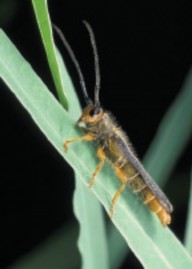
Figure 13. Oberea erythrocephala. Photo by Noah Poritz.
Impact of Biological Control Agents and Integration with Other Management
Five Aphthona species (A. cyparissiae, A. czwalinae, A. flava, A. lacertosa and A. nigriscutis) have established to varying degrees on leafy spurge in the United States and Canada and in a number of cases have significantly reduced spurge density at the release sites, attributed to flea beetle feeding. Near Edmonton, Canada, leafy spurge foliar cover decreased from 40 to 1.7 percent, five years after A. nigriscutis was released. At two sites in North Dakota, A. nigriscutis and A. czwalinae / A. lacertosa reduced foliar cover of leafy spurge from 45 to 7 percent over a three year period and reduced stem densities nearly 40-fold.
Integrating biological control agents with other management methods has proved highly successful. In many areas, infestations of leafy spurge have been successfully suppressed through a combination of flea beetles and controlled grazing by sheep. Herbicides combined with flea beetles (A. nigriscutis or A. czwalinae/A. lacertosa) or the gall midge (Spurgia esulae) controlled leafy spurge better than either method used alone. It may be necessary to separate the biocontrol and herbicide applications in and time and space in order to avoid harming the biocontrol population.
Collecting, Handling and Releasing Insects:
The following suggestions may help ensure successful collection and establish- ment of biocontrol agents:
- Before collecting biocontrols, determine habitat requirements for each species (Appendix I, p. 25) and locate release sites that meet those requirements. Prevent predation by avoiding sites with high ant and grasshopper populations. Insects should be released in areas free from grazing, herbicide or insecticide applications and general traffic. The initial release site should be protected for up to 10 years; secondary sites may not need as much protection. Grazing is possible on secondary sites if timed when biocontrol agents are not present on foliage (Appendix I, p. 25).
- Collections should be made with minimum stress to the insects. Hardy insects such as beetles can be collected by passing a sweep net through the upper portions of the leafy spurge plants eight or 10 times and then dumping the contents into a container.
- Release biocontrol agents as quickly as possible. If the insects are to be moved more than 50 miles or held longer than a few hours, the biocontrol agents should be sorted out so that predatory insects, spiders, ants, mites, etc., will not accompany them to the new location or kill them in transit. The agents should be kept cool during transport by placing them in a cooler with frozen coolant packs. Use a face towel, cardboard, or other means to prevent the containers from making direct contact with the frozen coolant packs in the cooler, which could harm the agents.
- Release biocontrol agents by sprinkling over a small area, usually 10 to 15 square yards, on a leafy spurge infestation of moderate density. Avoid tall, dense stands of plants that sometimes provide too much shade and high humidity. Release insects during the cool parts of the day.
- Permits are required to transport biocontrol insects or pathogens across state or provincial borders. In Montana and Wyoming, permits are obtained from the state Department of Agriculture and in North Dakota from the USDA Ani- mal and Plant Health Inspection Service.
- Control spurge around the insectaries to avoid expansion during insect establishment.
Pathogen Biocontrol Agents
Several plant pathogens have been tested on leafy spurge, including rust fungi, powdery mildews, soil borne fungi and foliar pathogens. To date, none have been found to be desirable agents due to wide host ranges (including domestic crops) or lack of permanent control.
CHEMICAL CONTROL
The costs of chemical control are most practical in cases of eradicating small patches and containing moderate infestations. Because of repeated treatments, chemical control of substantial infestations may be economically unfeasible and the use of sheep and/or biocontrolagents, supplemented with herbicide applications, becomes a more viable alternative. If determined economically feasible, chemical control of large infestations can be effective long-term when an adequate cover of desiredplants is present. The lack of adequate cover allows spurge or another weed species to become established after the residual effects of the herbicide have dissipated. Revegetate as necessary when desired plant cover is inadequate. Herbicide treatment programs that use annual applications provide the best long-term control strategy. Do not skip a year until control reaches 90 percent or more—otherwise leafy spurge will reinfest rapidly (Table 2). For assistance in selection and use of herbicides, contact your county Extension agent or weed coordinator.
Follow manufacturer label recommendations for all herbicides prior to application
Pasture and Rangeland
Tordon 22K® (picloram) is the most effective herbicide for managing leafy spurge. A cost-effective treatment for leafy spurge control is a tank mix of Tordon 22K® at one pint per acre combined with 2,4-D at one quart per acre applied annually during true flowering, approximately two weeks after appearance of the yellow bracts (Figure 14). This treatment has provided 85 percent leafy spurge control after four annual applications (Table 3) and was the most cost-effective treatment for leafy spurge. Fall application of this treatment may not effectively control leafy spurge.
Tordon 22K® at one quart per acre with 2,4-D at one quart per acre provides greater control, does not require retreatment as frequently, but is more expensive compared with Tordon 22K at one pint plus 2,4-D at one quart. This treatment can be applied either during true flowering or in the fall (Figure 14). An economical management option is to apply Tordon 22K at one quart per acre with 2,4-D at one quart per acre the first year, followed by Tordon 22K at one pint per acre plus 2,4-D at one quart per acre for three consecutive years.
Timing of herbicide application also affects herbicide efficacy on leafy spurge. For instance, fall-applied imazapic provides 80 to 90 percent leafy spurge control one year after treatment, but only 2- to 30 percent control when the same treatment is applied in the spring.
Table 2. Decrease in leafy spurge control with no treatment.
| Control 12 months after last treatment | Years without retreatment | ||
| 1 | 2 | 3 | |
| % control | |||
| 95% or more | 85 | 70 | < 20 |
| 80% | 60 | < 20 | 0 |
| 70% | < 30 | 0 | — |
| 60% | 20 | 0 | — |
Banvel® (dicamba) may provide intermediate levels of leafy spurge control in pastures and rangeland, but annual treatments with dicamba are not cost-effective.
Roundup® plus 2,4-D (glyphosate + 2,4-D) will provide season-long leafy spurge control, but there is a risk of grass injury, especially when applied in the fall. A single treatment of one pint Roundup plus one-pint 2,4-D per acre applied during early seed-set growth stage (Figure 14) will provide at least 75 percent leafy spurge control with up to 10 percent grass injury. This treatment should not be applied to the same area for two consecutive years because grass injury could be severe. Applications of Roundup® with 2,4-D should be followed by Tordon 22K® plus 2,4-D during the flowering stage the second year.
2,4-D amine at one quart per acre will give short-term control of leafy spurge top growth. Forage production can be increased when this treatment is applied annually in spring. Higher rates of 2,4-D do not provide significantly better control. Late summer dormancy D, or Tordon 22K® (solid line) and to Roundup® alone (dotted line) when applied at various times during the growing season.
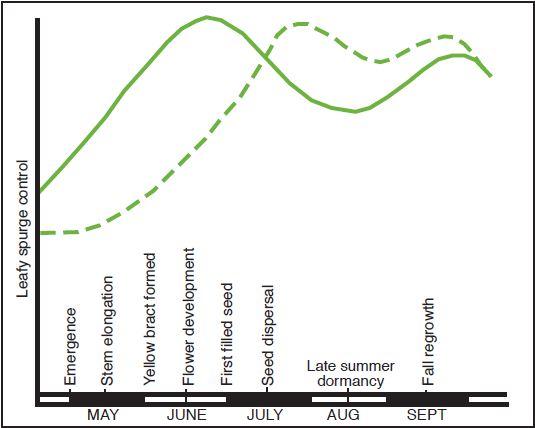
Figure 14. Susceptibility of leafy spurge to 2,4-D, Banvel®, Roundup® + 2,4- D, or Tordon 22K® (solid line) and to Roundup® alone (dotted line) when applied at various times during the growing season.
Control in Trees
2,4-D amine at one quart per acre may be used to control leafy spurge top growth under trees. Avoid contacting tree foliage and green bark of young trees with either direct spray or spray drift.
Roundup® at one quart per acre when grasses are dormant may give 80 to 90 percent leafy spurge control. Without retreatment, control drops to about 10 percent the second year. Treatments made prior to mid-July have not given good leafy spurge control. Roundup® is non-selective at higher rates and will kill grasses and other vegetation. Avoid contacting tree foliage and green bark of young trees with either spray or drift.
Roundup® combined with 2,4-D amine (one pint each) can be used under trees to control leafy spurge and decrease the amount of desired and vegetation injury caused by Roundup alone. Roundup with 2,4-D can be applied two to four weeks earlier than Roundup alone to obtain good control.
Table 3. Leafy spurge control in pastures and rangeland with herbicides generally applied annually, during the true-flower growth stage
| Year 1 | Years 2-4 | Months after initial treatment | |||||
| Herbicide | Rate | Herbicide | Rate | 12 | 24 | 36 | 48 |
| (product/ acre) | (product/ acre) | (% control) | |||||
| Tordon 22K | 1 quart | Tordon 22K | 1 quart | 65 | 70 | 75 | 90 |
| Tordon 22K | 2 quarts | — | — | 75 | 20 | 0 | — |
| Banvel | 2 quarts | Banvel | 2 quarts | 55 | 85 | 95 | — |
| 2,4-D1 | 2 quarts | 2,4-D | 2 quarts | 20 | 30 | 35 | 20 |
| Tordon 22K | 1 pint | Tordon 22K | 1 pint | 40 | 50 | 40 | 50 |
| Tordon 22K+ 2,4-D | 1 pint +1 quart | Tordon 22K+ 2,4-D | 1 pint +1 quart | 50 | 65 | our store, contact your county or reservation MSU Extension office, or e-mail orderpubs@montana.edu.
Copyright © 2023 MSU Extension We encourage the use of this document for nonprofit educational purposes. This document may be reprinted for nonprofit educational purposes if no endorsement of a commercial product, service or company is stated or implied, and if appropriate credit is given to the author and MSU Extension. To use these documents in electronic formats, permission must be sought from the Extension Communications Coordinator, 115 Culbertson Hall, Montana State University, Bozeman, MT 59717; E-mail: publications@montana.edu The U.S. Department of Agriculture (USDA), Montana State University and Montana State University Extension prohibit discrimination in all of their programs and activities on the basis of race, color, national origin, gender, religion, age, disability, political beliefs, sexual orientation, and marital and family status. Issued in furtherance of cooperative extension work in agriculture and home economics, acts of May 8 and June 30, 1914, in cooperation with the U.S. Department of Agriculture, Cody Stone, Director of Extension, Montana State University, Bozeman, MT 59717 | |

